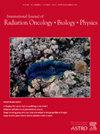Phase 1 Study of Adjuvant Allogeneic Granulocyte-Macrophage Colony-Stimulating Factor–Transduced Pancreatic Tumor Cell Vaccine, Low-Dose Cyclophosphamide, and Stereotactic Body Radiation Therapy Followed by FOLFIRINOX in High-Risk Resected Pancreatic Ductal Adenocarcinoma
IF 6.4
1区 医学
Q1 ONCOLOGY
International Journal of Radiation Oncology Biology Physics
Pub Date : 2024-11-14
DOI:10.1016/j.ijrobp.2024.10.039
引用次数: 0
Abstract
Purpose
Local and distant progression remains common following resection of resectable pancreatic ductal adenocarcinoma (PDAC) despite adjuvant multiagent chemotherapy. We report a prospective institutional phase 1 trial incorporating adjuvant GVAX vaccine, low-dose cyclophosphamide (Cy), and stereotactic body radiation therapy (SBRT) followed by FOLFIRINOX (FFX) among patients who underwent resection of high-risk PDAC.
Patients and Methods
The study design was a modified 3+3. Cohort 1 received 5-fraction SBRT to 33 Gy to the tumor bed and 25 Gy to elective nodes followed by 6 cycles of full-dose FFX. After toxicity review, cohort 2 had SBRT and was switched to modified FFX (mFFX). Cohort 3 had 1 cycle of Cy/GVAX followed by SBRT, mFFX, and 4 cycles of maintenance Cy/GVAX with 6-month Cy/GVAX boosts until progression.
Results
Nineteen patients were enrolled with a median follow-up of 36.2 months. To be eligible, patients were required to have close/positive margins (within ≤1 mm) (71%) and/or lymph node metastasis (79%). Overall, 63% of patients had both. In cohort 1, 67% of patients received 6 cycles of FFX; in cohort 2, 75% received 6 cycles of modified FFX. In cohort 3, 12 patients received the first dose of Cy/GVAX and SBRT with 10 individuals (83%) receiving 6 cycles of mFFX. Cohort 3 had acceptable levels of grade ≥3 thrombocytopenia, neutropenia, and diarrhea after 2 cycles of mFFX. Median overall survival (OS)/disease-free survival (DFS) for the overall cohort and cohort 3 was 36.2/18.2 months and 61.3/24.1 months, respectively. One- and 2-year OS for cohort 3 was 83%/75%, respectively. At the last follow-up (median = x), 5 patients were alive (42%) in cohort 3.
Conclusions
This is the first prospective trial to evaluate adjuvant GVAX, Cy, SBRT, and mFFX in resected PDAC patients with high-risk features. This combination regimen was well tolerated with limited toxicity and promising survival outcomes, warranting future studies to validate this regimen in the adjuvant setting.
高风险切除胰腺导管腺癌辅助异体 GM-CSF 转导的胰腺肿瘤细胞疫苗、低剂量环磷酰胺和 SBRT 后 FFX 的 I 期研究。
目的:可切除胰腺导管腺癌(PDAC)切除术后,尽管进行了多药辅助化疗,但局部和远处进展仍很常见。我们报告了一项前瞻性机构I期试验,在接受高危PDAC切除术的患者中纳入了GVAX疫苗、低剂量环磷酰胺(Cy)和SBRT,然后进行FOLFIRINOX(FFX)辅助治疗:研究设计为改良的3+3。第一组患者接受5分次SBRT治疗,肿瘤床33 Gy,选择性结节25 Gy,然后接受6个周期的全剂量FFX治疗。经过毒性审查后,第 2 组患者接受了 SBRT,并改用改良 FFX(mFFX)。第3组患者接受1个周期的Cy/GVAX治疗,然后进行SBRT、mFFX和4个周期的Cy/GVAX维持治疗,并每6个月进行一次Cy/GVAX增强治疗,直至病情进展:19名患者入组,中位随访时间为36.2个月。符合条件的患者需要有近端/阳性边缘(≤1 mm以内)(71%)和/或淋巴结转移(79%)。总体而言,63%的患者同时存在这两种情况。在队列 1 中,67% 的患者接受了 6 个周期的 FFX;在队列 2 中,75% 的患者接受了 6 个周期的改良 FFX。在队列 3 中,12 名患者接受了第一剂 Cy/GVAX 和 SBRT,其中 10 人(83%)接受了 6 个周期的 mFFX。队列 3 在接受两个周期的 mFFX 治疗后,血小板减少、中性粒细胞减少和腹泻的程度≥3 级。总体队列和队列3的中位OS/DFS分别为36.2/18.2个月和61.3/24.1个月。队列3的1年和2年OS分别为83%/75%。最后一次随访时(中位数= x),队列3中有5名患者存活(42%):这是首次对具有高风险特征的PDAC切除患者进行GVAX、Cy、SBRT和mFFX辅助治疗评估的前瞻性试验。该联合方案耐受性良好,毒性有限,生存结果良好,值得在今后的研究中验证该方案在辅助治疗中的有效性。
本文章由计算机程序翻译,如有差异,请以英文原文为准。
求助全文
约1分钟内获得全文
求助全文
来源期刊
CiteScore
11.00
自引率
7.10%
发文量
2538
审稿时长
6.6 weeks
期刊介绍:
International Journal of Radiation Oncology • Biology • Physics (IJROBP), known in the field as the Red Journal, publishes original laboratory and clinical investigations related to radiation oncology, radiation biology, medical physics, and both education and health policy as it relates to the field.
This journal has a particular interest in original contributions of the following types: prospective clinical trials, outcomes research, and large database interrogation. In addition, it seeks reports of high-impact innovations in single or combined modality treatment, tumor sensitization, normal tissue protection (including both precision avoidance and pharmacologic means), brachytherapy, particle irradiation, and cancer imaging. Technical advances related to dosimetry and conformal radiation treatment planning are of interest, as are basic science studies investigating tumor physiology and the molecular biology underlying cancer and normal tissue radiation response.

 求助内容:
求助内容: 应助结果提醒方式:
应助结果提醒方式:


